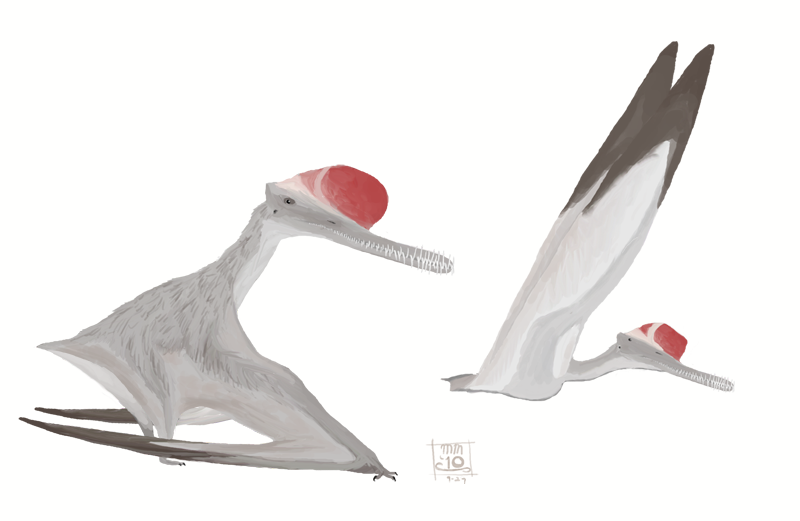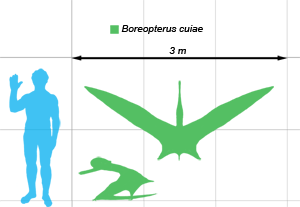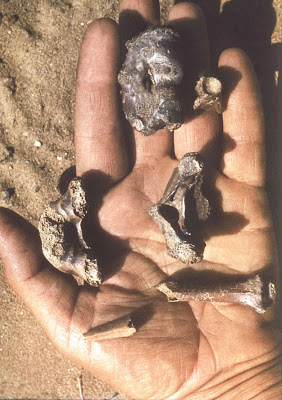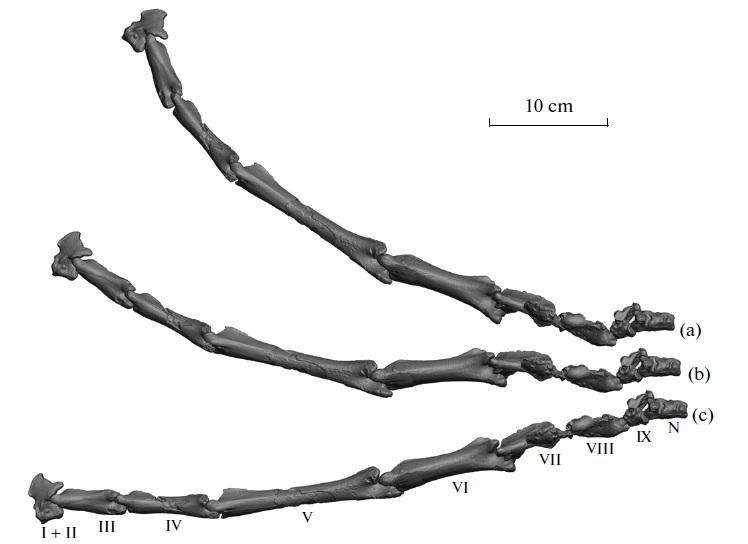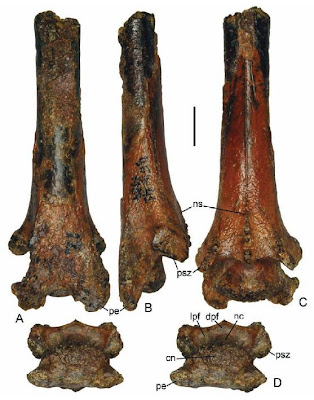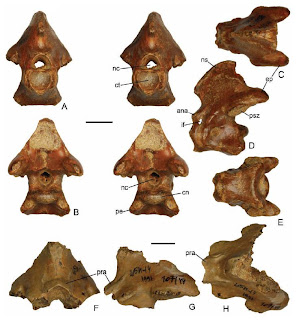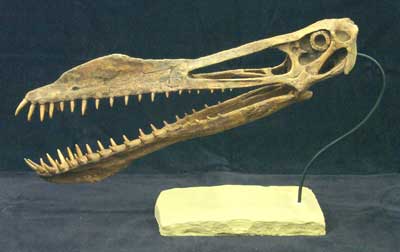[Recent Entries][Archive][Friends][User Info]
Below are 10 entries, after skipping 40 most recent ones in the "Сообщество, посвящённое ра" journal:| May 7th, 2014 | |
|---|---|
| 08:04 pm [industrialterro] [Link] |
Caulkicephalus Caulkicephalus is a genus of pterosaur, belonging to the Pterodactyloidea, from the Isle of Wight off the coast of England. Between 1995 and 2003 bone fragments of an unknown pterosaur were found at the Yaverland locality near Sandown. The discoveries were made in or from a brown clay layer from the Wessex Formation of the Wealden Group, stemming from the Early Cretaceous (Barremian age, about 130 million years ago). In 2005 a new genus was named and described by Lorna Steel, David Martill, David Unwin and John Winch. The type species is Caulkicephalus trimicrodon. The genus name is a translation of "Caulkhead", a traditional nickname for Isle of Wight residents, partially derived from Greek kephale, "head". The specific name, trimicrodon, means "three small teeth", in reference to the dentition. The holotype is IWCMS 2002.189.1, 2, 4: three pieces, more or less contiguous, of the front part of a snout. As paratypes have been referred: IWCMS 2002.189.3, a partial posterior skull roof; IWCMS 2003.2, a left quadrate; IWCMS 2003.4, a possible partial jugal; ICWMS 2002.237, a 44 millimetres long fragment of the first phalanx of the wing finger; IWCMS 2002.234.1-4, four, together 245 millimetres long, contiguous fragments of a first phalanx; IWCMS 2002.233, a possible distal end, 64 millimetres long, of a second phalanx; IWCMS 2002.236, a fragment of the shaft of possibly the fourth phalanx; and IWCMS 2003.3, a probable fragment of a hindlimb bone. The fossils have only been slightly compressed. The snout fragments have a combined length of 290 millimetres. On the snout top the base of a crest is visible, not quite reaching its rounded tip. The teeth have, apart from some replacement teeth present deep in the jaw, been lost but their number, orientation and size can be inferred from the tooth sockets, which however are partly missing at the right side. These are oval and slightly elevated above the jaw bone. The first two tooth pairs were pointed somewhat to the front; the teeth more to the back pointed more sideways; the most posterior preserved stood perpendicular to the jaw. The teeth increased in size until the third pair which was the largest. The fourth pair was equal to the first but the fifth, sixth and seventh pairs were markedly smaller, less than half in size; it is this feature which is recalled by the specific name. Pairs eight, nine and ten again equalled the first. After a narrow hiatus between the second and third snout fragment four tooth sockets are present at each side of the latter, but these are not placed in opposite pairs. The number of teeth in the upper jaw thus seems to have been at least fourteen. The smaller sized teeth were placed in a constriction of the snout, which thus had a broader end with larger teeth, a so-called "prey grab", usually interpreted as an adaptation to catch slippery prey such as fish. The posterior skull fragment, a braincase which is rather damaged, shows on its top the base of a parietal crest, probably pointing towards the back. It seems to have been separate from the snout crest. Caulkicephalus was by the describers assigned to the Ornithocheiridae in view of the narrowing in the middle of the snout. The snout crest was seen as an indication it belonged to the more general Ornithocheiroidea sensu Unwin, whereas the parietal crest was suggested to have been a synapomorphy, a shared new feature, of the more narrow group of the Euornithocheira. Unique characters of the species itself, its autapomorphies, are the details of its dentition, the downwards and backwards running suture between the praemaxilla and maxilla, and the fact the median ridge of the palate begins (or ends) at the ninth tooth pair. The layer the fossils were found in, does not consist of marine sediments, but contains land plant debris; this is seen as an indication of a more terrestrial habitat. David Martill estimated Caulkicephalus had a wingspan of around 5 metres (16.5 ft). Tags: Вымершие рептилии, Мел, авеметатарзалии, архозавроморфы, архозавры, диапсиды, монофенестраты, орнитохейриды, орнитохейройды, птеранодонтойды, птеродактили, птерозавры |
| April 30th, 2014 | |
| 03:05 pm [industrialterro] [Link] |
Boreopterus Boreopterus is a genus of pterodactyloid pterosaur from the Barremian-Aptian-age Lower Cretaceous Yixian Formation of Dalian, Liaoning, China. The genus was in 2005 named by Lü Jinchang and Ji Qiang. The type species is Boreopterus cuiae. The genus name is derived from Greek boreios, "northern" and pteron, "wing". The specific epithet was chosen to dedicate Cui Xu. The genus is based on holotype JZMP-04-07-3, a nearly complete but crushed skeleton and skull. The skull is 235 millimeters long (9.25 inches), low and elongated with a rounded tip. Its wingspan is estimated to have been around 1.45 meters (4.76 feet). Its teeth, especially the anterior nine pairs, are quite large, forming a mesh of sharp teeth at the front of the mouth; the third and fourth teeth from the front are the largest. There are at least 27 teeth in each side of both the upper and lower jaws, which is a large amount. Lü and Ji initially placed Boreopterus in the Ornithocheiridae when they described it in 2006, a classification which was supported later that year by David Unwin. However, Lü in 2006 published a cladistic analysis showing Boreopterus to be the sister taxon of Feilongus (together forming the new family, Boreopteridae) in a position more basal than Haopterus. In 2013, a more comprehensive study of pterosaur relationships supported the close relationship of Boreopterus and Feilongus, as well as their relatively basal status among pterodactyloids. Andres & Myers (2013) found the "boreopterids" as the sister group of Cycnorhamphus within the archaeopterodactyloid group Gallodactylidae. Pterosaurs like Boreopterus are interpreted by Unwin as soaring animals, like today's albatrosses and frigatebirds. However, it has also been suggested that boreopterids foraged while swimming, trapping small prey with their needle-like teeth, a method similar to that of modern Platanista dolphins. It has been suggested that the closely related Zhenyuanopterus was merely the adult form of this animal. Boreopteridae (meaning "northern wings") is a group of ornithocheiroid pterosaurs from the Aptian-age Lower Cretaceous Yixian Formation of Liaoning, China. In 2006, Lu and colleagues named the clade Boreopteridae for the clade containing the common ancestor of Boreopterus and Feilongus and all its descendants, which the authors reclassified as close relatives of the ornithocherids. (Feilongus had originally been considered a gallodactylid). Many possible boreopterids were subsequently described, one possible example being Aetodactylus, which has been claimed to be similar to Boreopterus. Originally considered close relatives of the ornithocheirids, many of these supposed boreopterids have been found to belong to other groups of the pterodactyloid lineage. Boreopterus and Feilongus were found by Andres and colleagues in 2013 to be closely related to Cycnorhamphus, making them members of the Gallodactylidae as had been originally thought when Feilongus was discovered. A subsequent analysis including the other supposed boreopterids found that Boreopterus itself, and therefore the name Boreopteridae, was indeed a member of the ornithocheiroid clade, but that Feilongus was in fact a ctenochasmatoid closely related to Gnathosaurus. According to Andres and colleagues (2014), the true boreopterid clade is limited to Boreopterus, Guidraco, and Zhenyuanopterus. The known taxa come from the Yixian Formation of Liaoning, which represented a lake system, suggesting that these animals occurred in freshwater habitats. They are thought to have foraged while swimming, trapping prey with their needle-like teeth; this method of fishing was probably analogous to that of Platanista dolphins, which share a similar dentition. Many possible ornithocheirid remains might actually belong to boreopterids, a possible example being Aetodactylus, which has been claimed to be similar to Boreopterus Размеры тела в сравнении с человеком: Tags: Вымершие рептилии, Мел, авеметатарзалии, архозавроморфы, архозавры, бореоптериды, диапсиды, монофенестраты, орнитохейройды, птеранодонтойды, птеродактили, птерозавры |
| 02:34 pm [industrialterro] [Link] |
Bakonydraco Bakonydraco is a genus of azhdarchoid pterosaur of the Santonian-age Upper Cretaceous Csehbánya Formation of the Bakony Mountains, Iharkút, Veszprém, western Hungary. The genus was named in 2005 by David Weishampel, Atilla Ősi and Jianu Coralia. The type species is Bakonydraco galaczi. The genus name refers to the Bakony Mountains and to Latin draco, "dragon". The specific epithet galaczi honors Professor András Galácz, who helped the authors in the Iharkút Research Program, where fossils are since 2000 found in open-pit mining of bauxite, among them the remains of pterosaurs, the first ever discovered in Hungary. Bakonydraco is based on holotype MTM Gyn/3, a nearly complete mandibula, a fusion of the lower jaws. Also assigned to it, as paratype, is MTM Gyn/4, 21: parts from another jaw's symphysis (the front parts, having fused into a single blade-like structure, of the two lower jaws); azhdarchid wing bones and neck vertebrae from the same area may also belong to it. The lower jaws are toothless and the two halves of the mandibula are frontally fused for about half of its overall length, forming a long, pointed section that is compressed side-to-side and also expanded vertically, giving it a somewhat spearhead- or arrowhead-like shape from the side. This expansion occurs both on the lower edge and on the top surface, where the most extreme point corresponds with a transverse ridge which separates the straight back half of the symphysis from the pointed end in the front. The jaws of MTM Gyn/3 are 29 centimeters long (11.4 inches), and the wingspan of the genus is estimated to be 3.5 to 4 meters (11.5 to 13.1 feet), which is medium-sized for a pterosaur. Because the jaws are relatively taller than other azhdarchids, and reminiscent of Tapejara, Bakonydraco may have fed differently from other azdarchids. It could have been a piscivore (feeding on small fish), or a frugivore. The discovery of this genus establishes the presence of azhdarchids in the Late Cretaceous of Hungary, suggesting that there as elsewhere they had become the dominant pterosaurs. Andres & Myers (2013) have proposed that Bakonydraco is actually a tapejarid, a sister taxon to Tapejara and Tupandactylus. Indeed, the original paper describing this species compared the holotype jaw to Tapejara and Sinopterus, implicating its affinities to this clade (or at least a large amount of convergence). If Bakonydraco is a tapejarid, it represents the only Late Cretaceous record of Tapejaridae known to date. Tags: Вымершие рептилии, Мел, авеметатарзалии, аждархойды, архозавроморфы, архозавры, диапсиды, монофенестраты, орнитохейройды, птеродактили, птерозавры |
| 12:54 pm [industrialterro] [Link] |
Azhdarcho Azhdarcho /ɑːʒˈdɑrxoʊ/ is a genus of pterodactyloid pterosaur from the late Cretaceous Period of the Bissekty Formation (middle Turonian stage, about 92 million years ago) of Uzbekistan. It is known from fragmentary remains including the distinctive, elongated neck vertebrae that characterizes members of the family Azhdarchidae, which also includes such giant pterosaurs as Quetzalcoatlus. The name Azhdarcho comes from the Uzbek word azhdarkho [adʒˈdarχɒ], the name of a dragon in Uzbek mythology. The type species is Azhdarcho lancicollis. The specific epithet lancicollis is derived from the Latin words lancea (meaning "lance" or "spear") and collum ("neck"). The fossil remains of Azhdarcho were recovered in the Kyzyl Kum desert (from the Taykarshinskaya unit of the Bissekty Formation) by Lev A. Nesov during expeditions to Central Asia in 1974-1981. The type specimen, given the catalog number TsNIGRmuzey 1/11915, consists of an anterior neck vertebra. Twelve paratypes were referred, including several other neck vertebrae, elements from the wing and leg, and pieces of the jaw. These specimens, along with other vertebrate fossils collected during the expeditions, were deposited at the F.N. Chernyshev Central Geologic Exploration Museum in St. Petersberg. In his description of the type specimen of Azhdarcho lancicollis, Nesov noted its distinctive neck vertebrae, which are extremely elongated and round in cross section at mid-length. He pointed out similar characteristics in several other pterosaurs, and used them to erect the new subfamily Azhdarchinae, within the Pteranodontidae. Nesov also referred Quetzalcoatlus and Arambourgiania (then known as Titanopteryx) to this subfamily, which was subsequently re-classified as the family Azhdarchidae. He also suggested that similar, thin-walled pterosaur bones from the Lance Formation of Wyoming could be assigned to a species of Azhdarcho, using this as evidence of commonalities between the fauna of Late Cretaceous central Asia and western North America. However, subsequent research has not followed this suggestion, and A. lancicollis is the only currently recognized species of Azhdarcho. In the original description of Azhdarcho, Nesov noted that because of the way the vertebrae articulated, the pterosaur would have had very limited flexibility in the neck. Azhdarcho could not rotate its neck at all, though it could flex the neck vertically to a certain degree. Nesov suggested that pterosaurs like Azhdarcho may have fed in a manner similar to the modern Skimmer, with their long necks allowing them to scoop prey from the water's surface and small depths without needing to dive. However, recent research has shown that skimming requires more energy and anatomical specializations than previously thought, and that large pterosaurs like Azhdarcho probably were not capable of skimming. The long neck would also have allowed azhdarchids to hunt for food in the water or on the bottom while swimming, or to hunt poorly-flying vertebrates in the air, though Nesov also suggested that the animal would have needed stable weather conditions to fly well, and suggested azhdarchid habitats needed to be dominated by even, mild winds. ( Read More )</span>
Ископаемые останки (1, 2, 3, 4): Tags: Вымершие рептилии, Мел, авеметатарзалии, аждархиды, аждархойды, архозавроморфы, архозавры, диапсиды, монофенестраты, орнитохейройды, птеродактили, птерозавры |
| April 23rd, 2014 | |
| 01:42 pm [industrialterro] [Link] |
Anhanguera Anhanguera (meaning "old devil") is a genus of pterodactyloid pterosaur known from the Lower-Cretaceous (Aptian age, 112Ma) Santana Formation of Brazil, with referred specimens found in the Upper Chalk Formation and Cambridge Greensand of the UK (up to the late Cenomanian age, 94Ma). This pterosaur is closely related to Ornithocheirus, and belongs in the family Ornithocheiridae within its own subfamily, Anhanguerinae. Anhanguera was a fish-eating animal with a wingspan of about 4.5 m (15 ft). Like many other ornithocheirids, Anhanguera had a rounded crests at front of its upper and lower jaws, which were filled with angled, conical but curved teeth of various sizes and orientations. Like many of its relatives, the jaws were tapered in width, but expanded into a broad, spoon-shaped rosette at the tip. It is distinguished from its relatives by subtle differences in the crest and teeth: unlike its close relatives Coloborhynchus and Ornithocheirus, the crest on the upper jaw of Anhanguera did not begin at the tip of the snout, but was set farther back on the skull. Like many ornithocheiroids, (most notably the pteranodonts but also in ornithocheirids such as Ludodactylus) Anhanguera had an additional crest protruding from the back of the skull. However, it was reduced to a small, blunt projection in these animals. A study in 2003 showed that Anhanguera held its head at an angle to the ground due to its inner ear structure, which helped the animal detect its balance. There are several recognized species of Anhanguera. A. santanae and A. blittersdorfi are known from several fragmentary remains including skulls from the Santana Formation of Brazil. A. cuvieri and A. fittoni, initially described as belonging to the genus Pterodactylus and then Ornithocheirus, are from a slightly later period (Albian) from England, while fragments of pterosaurs that may have affinities with Anhanguera have also been found in Queensland, Australia. The well-known species A. piscator has been redescribed as belonging to the genus Coloborhynchus (Veldmeijer, 2003). Anhangueridae is a group of pterosaurs within the suborder Pterodactyloidea. They were among the last pterosaurs to possess teeth. A recent study discussing the group considered the Anhangueridae to be typified by a premaxillary crest and a lateral expansion in the distal rostrum. The same study presented a cladistic analysis, for which an "Agreement subtree" was calculated. The Anhangueridae was found to be sister taxon to the large crested "Tropeognathus". ( Read More ) Репродукции (1, 2, 3, 4, 5, 6, 7, 8): ( Read More ) Ископаемые останки (1, 2, 3, 4, 5): Tags: Вымершие рептилии, Мел, авеметатарзалии, аньянгуэриды, архозавроморфы, архозавры, диапсиды, монофенестраты, орнитохейройды, птеранодонтойды, птеродактили, птерозавры |
| 12:56 pm [industrialterro] [Link] |
Arambourgiania Arambourgiania is a pterosaur from the Late Cretaceous (Maastrichtian) of Jordan. It was one of the largest members of this group. In the early forties, a railway worker during repairs on the Amman-Damascus railroad near Russeifa found a two feet long fossil bone. In 1943 this was acquired by the director of a nearby phosphate mine, Amin Kawar, who brought it to the attention of a British archeologist, Fielding, after the war. This generated some publicity — the bone was even shown to Abdullah I of Jordan — but more importantly, it made the scientific community aware of the find. In 1953 the fossil was sent to Paris, where it was examined by Camille Arambourg of the Muséum national d'histoire naturelle. In 1954, he concluded the bone was the wing metacarpal of a giant pterosaur. In 1959, he named a new genus and species: Titanopteryx philadelphiae. The genus name meant "titan wing" in Greek; the specific name refers to the name of Amman in Antiquity: Philadelphia. Arambourg let a plaster cast be made and then sent the fossil back to the phosphate mine; this last aspect was later forgotten and the bone was assumed lost. In 1975 Douglas A. Lawson, studying the related Quetzalcoatlus, concluded the bone was not a metacarpal but a cervical vertebra. In the eighties, Russian paleontologist Lev Nesov was informed by an entomologist that the name Titanopteryx had already been given by Günther Enderlein to a fly from the Simulidae family in 1934. Therefore, in 1987 he renamed the genus into Arambourgiania, honouring Arambourg. However, the name "Titanopteryx" was informally kept in use in the West, partially because the new name was assumed by many to be a nomen dubium. Early 1995, paleontologists David Martill and Eberhard Frey traveled to Jordan in an attempt to clarify matters. In a cupboard of the office of the Jordan Phosphate Mines Company they discovered some other pterosaur bones: a smaller vertebra and the proximal and distal extremities of a wing phalanx — but not the original find. However, after their departure to Europe engineer Rashdie Sadaqah of the mine investigated further and in 1996 established it had been bought from the company in 1969 by geologist Hani N. Khoury who had donated it in 1973 to the University of Jordan; it was still present in the collection of this institute and now could be restudied by Martill and Frey. The holotype, VF 1, consists of a very elongated cervical vertebra, probably the fifth. Today the middle section is missing; the original find was about 62 centimetres long, but had been sawed into three parts. Most of the fossil consists of an internal infilling or mould; the thin bone walls are missing on most of the surface. The find had not presented the whole vertebra; a piece was absent from its posterior end as well. Frey and Martill estimated the total length to have been 78 centimetres, using for comparison the relative position of the smallest shaft diameter of the fifth cervical vertebra of Quetzalcoatlus. From this again the total neck length was extrapolated at about three metres. From the relatively slender vertebra the length dimension was then selected to be compared to that of Quetzalcoatlus, estimated at 66 centimeters long, resulting in a ratio of 1.18. Applying that ratio to the overall size, Frey and Martill in 1998 concluded that the wingspan of Arambourgiania had been twelve to thirteen metres, compared with the ten to eleven metres of Quetzalcoatlus, and that Arambourgiania was thus the largest pterosaur then known. Later estimates have been more moderate, sometimes as low as seven metres. Frey and Martill rejected the suggestion that Arambourgiania was a nomen dubium or identical to Quetzalcoatlus and affirmed its validity in relation to "Titanopteryx". Nesov in 1984 had placed the species within Azhdarchinae, part of the Pteranodontidae; the same year Kevin Padian placed it within Titanopterygidae. Both concepts have fallen into disuse now that such forms are commonly assigned to the Azhdarchidae.
Tags: Вымершие рептилии, Мел, авеметатарзалии, аждархиды, аждархойды, архозавроморфы, архозавры, диапсиды, монофенестраты, орнитохейройды, птеродактили, птерозавры |
| 10:48 am [industrialterro] [Link] |
Alanqa Alanqa (от араб. «Al Anqa» — феникс) — вымерший род птеродактелей, обитавший в меловом периоде примерно 95 млн лет назад. Ископаемые останки были найдены в отложениях сеноманского яруса в Марокко и описаны в 2010 году. Единственный известный вид — Alanqa saharica Ibrahim et a., 2010. Название птеродактиля Alanqa saharica происходит от арабского слова «Al Anqa», которое означает «Феникс», а видовое название saharica указывает на то, что данный вид был обнаружен в пустыне Сахара. Описание A. saharica основано на исследовании челюстной кости длиной 344 мм, составленной из трёх отдельных фрагментов. Также были найдены фрагменты шейных позвонков, принадлежавших, вероятно, A. saharica. Длина птеродактеля составляла примерно шесть метров. Отличительной особенностью A. saharica является отсутствие зубов. Является одним из древнейших известных представителей семейства аждархид. Окаменелости птерозавра находились на территории древней Гондваны (на территории современного Марокко), однако подавляющее большинство сравнимых по возрасту экземпляров аждархид было обнаружено на землях бывшей Лавразии. Так же рядом с останками Alanqa были обнаружены 2 других вида птерозавров, что свидетельствует о тесном соседстве разных видов птерозавров на одной территории и на одном промежутке времени. Aided by local villagers, a team of paleontologists had been excavating at several locations in the Kem Kem Beds during April, and November to December 2008, uncovering remains of several different pterosaurs. The material was fragmentary, and the type locality for Alanqa is Aferdou N'Chaft, near the village of Begaa and 10 km to the north-east of Taouz. Alanqa is known only from five fragments of the front upper and lower jaws, and possibly a neck vertebra, representing the single type species Alanqa saharica. Two of these fragments were first described, but not named, by Wellnhofer and Buffetaut in 1999. Three additional jaw specimens, including a better preserved upper jaw, were described and named by Ibrahim and colleagues in 2010. The jaws were straight and pointed, like those of Quetzalcoatlus and Zhejiangopterus, so while it was originally proposed as a pteranodontid, it is more likely Alanqa was an azhdarchid. Based on comparison to related species, the Alanqa saharica the individuals known from jaw specimens probably had wingspans of about 4 meters (about 13 ft). However, according to Ibrahim and colleagues, the vertebra (which probably belonged to the same species) appeared to come from a larger individual, measuring about 6 meters (about 20 ft) in wingspan. ( Read More ) Tags: Вымершие рептилии, Мел, авеметатарзалии, аждархиды, аждархойды, архозавроморфы, архозавры, диапсиды, монофенестраты, орнитохейройды, птеродактили, птерозавры |
| April 20th, 2014 | |
| 07:04 pm [industrialterro] [Link] |
Aetodactylus Aetodactylus (meaning "eagle finger") is a genus of ornithocheirid pterodactyloid pterosaur. It is known from a lower jaw discovered in Upper Cretaceous rocks of northeastern Texas, United States. Aetodactylus is only the second ornithocheirid genus to be discovered in North America. Aetodactylus is based on SMU 76383 (Shuler Museum of Paleontology, Southern Methodist University), a nearly complete lower jaw lacking the right retroarticular process (the bony prong posterior to the jaw joint), part of the posterior end of the mandibular symphysis (where the two halves of the lower jaw meet), and all but two teeth. This specimen was found in 2006 by Lance Hall near a construction site in Mansfield, near Joe Pool Lake (recorded as SMU Loc. 424). The rock it was found in is a calcareous marine sandstone rich in mud–sized particles, from the middle Cenomanian-age (approximately 97 million years old) Tarrant Formation. Also found were fish teeth and vertebrae, and indeterminate bones. The Tarrant Formation is the lowest rock unit of the Cenomanian–Turonian–age Eagle Ford Group. Aetodactylus was named by Timothy S. Myers of SMU in 2010. The type species is A. halli, named in honor of the discoverer. Aetodactylus is differentiated from other ornithocheirids by several anatomical details of the lower jaw, including the slight expansion of the anterior end of the lower jaw, the strong vertical compression of the symphysis, the relatively constant spacing of the teeth, and the slight upward curve of the lower jaw. Myers found that Aetodactylus compared best with the Chinese genus Boreopterus. Aetodactylus represents one of the youngest definitive records of ornithocheirids. The jaw SMU 76383 is 38.4 centimetres (15.1 in) long, 15.8 centimetres (6.2 in) (~41%) of which is joined left and right jaws. 27 pairs of teeth were present; the two remaining teeth are pointed, curved slightly backward, flattened from side to side, and slender. The tip of the jaw is slightly expanded (to 1.6 centimetres (0.63 in) from a minimum of 1.3 centimetres (0.51 in) just posterior) and contains the first four pairs of teeth, with the first pair projecting forward. Based on the size of the tooth sockets, the teeth of the second and third pairs were largest, with tooth size decreasing posteriorly. There are small pits between the posterior teeth, interpreted as points where the teeth of the upper jaw rested against the lower jaw. These pits disappear partway along the tooth row, suggesting that the anterior teeth of the upper jaws were longer and projected outwards to a degree. Unlike some other ornithocheirids, such as Anhanguera, Coloborhynchus, and Ornithocheirus, there is no bony crest on the lower jaw. It is possible that Aetodactylus might be a boreopterid, as Myers identifies it as being closely related to Boreopterus, and many ornithocheirid remains might belong to boreopterids instead. ( Read More )
Tags: Вымершие рептилии, Мел, авеметатарзалии, архозавроморфы, архозавры, диапсиды, монофенестраты, орнитохейриды, орнитохейройды, птеранодонтойды, птеродактили, птерозавры |
| May 23rd, 2012 | |
| 08:22 pm [industrialterro] [Link] |
Puntanipterus Puntanipterus was a genus of dsungaripterid pterodactyloid pterosaur from the Upper Jurassic-Lower Cretaceous La Cruz Formation of San Luis, Argentina. The genus was in 1975 named by José Bonaparte and Teresa Sánchez. The type species is Puntanipterus globosus. The genus name refers to the Puntanos, the colloquial name for the inhabitants of the province of San Luis after the old name of their capital "San Luis de la Punta de los Venados", and combines this with a Latinized Greek pteron, "wing". The specific name means "spherical" in Latin, a reference to the form of the lower tibia. It is based on holotype PVL 3869 (earlier FML 3869) found in 1972, a 105 millimetres long tibiotarsus and seven centimetres long fibula; referred to it were a back vertebra and a wing and foot phalanx. The leg bones were described as similar to those of Pterodaustro (from slightly younger rocks), except for having an expanded spherical joint at the ankle and spiny processes on the side faces of the tibia at that end. Bonaparte in 1978 classified Puntanipterus as a member of the Pterodaustridae. The same year Peter Wellnhofer was more careful and limited his assessment to a Pterodactyloidea incertae sedis. In 1980 Peter Galton concluded it belonged to the Dsungaripteridae. It was still by many considered to be a dsungaripterid by the time Peter Wellnhofer published The Illustrated Encyclopedia of Pterosaurs (several editions in the 1990s). However, in the nineties several tibiae conforming to that of Puntanipterus were found in the same strata as Pterodaustro; a direct comparison is only impossible because more complete specimens of the latter are always very compressed, deforming the ankle morphology; but smaller fragments containing not-compressed ankles all have the build of a Puntanipterus tibiotarsus. This is by South American workers seen as a strong indication that both forms are identical. Glut reports a personal communication from Laura Codorniú and Luis Chiappe (2004) that Puntanipterus should be regarded as a junior synonym of Pterodaustro, but it remains to be seen if this will be supported in the future; it was not done in David Unwin's The Pterosaurs: From Deep Time, published in 2006 (he recognized it as a possibly valid species of uncertain relationships).
Tags: Вымершие рептилии, Юра, авеметатарзалии, аждархойды, архозавроморфы, архозавры, джунгариптероиды, диапсиды, монофенестраты, орнитохейройды, птеродактили, птерозавры |
| May 22nd, 2012 | |
| 07:02 pm [industrialterro] [Link] |
Germanodactylus Germanodactylus ("German finger") is a genus of dsungaripteroid pterodactyloid pterosaur from Late Jurassic-age rocks of Germany, including the Solnhofen limestone. Its specimens were long thought to pertain to Pterodactylus. Its head crest is a distinctive feature. Germanodactylus is described as being "raven-sized" in weight. G. cristatus had a 0.98 wingspan (3.2 ft) and a 13 centimeter long (5.1 in) skull, while G. rhamphastinus was somewhat larger, with a 1.08 meter wingspan (3.5 ft) and a skull 21 centimeters long (8.3 in). Germanodactylus is known for its head crest, which had a bony portion (a low ridge running up the midline of the skull) and a soft-tissue portion that more than doubled its height. The bony part does not go as far up the head in G. cristatus as in G. rhamphastinus. The soft-tissue portion was not known early on, being first described in 2002 by S. Christopher Bennett. It was probably composed of cornified epidermis. Germanodactylus is the first genus for which a soft-tissue component of the crest is known, but similar structures were probably widespread among pterosaurs. This genus is unspecialized compared to the pterosaurs of the Cretaceous, and has had varying placements in Pterosauria. Yang Zhongjian, who named the genus, gave it its own family Germanodactylidae. Bennett included the genus in the family Pterodactylidae, and Alexander W.A. Kellner found it to be related to Pterodactylus in his 2003 phylogenetic analysis. David M. Unwin, on the other hand, preferred to consider it a basal dsungaripteroid, a group that evolved into dedicated shellfish-eaters. G. cristatus is based on specimen BSP 1892.IV.1, from the Solnhofen limestone of Eichstätt, Germany. It was originally described by Plieninger in 1901 as a specimen of Pterodactylus kochi, and was given its current specific name by Carl Wiman in 1925, meaning "crested" in Latin. Yang Zhongjian determined that it deserved its own genus in 1964. Second species G. ramphastinus (in 1858 accidentally revised to rhamphastinus by Christian Erich Hermann von Meyer) was named as a distinct species long before G. cristatus, described by Johann Andreas Wagner in 1851 as a species of the now deprecated genus Ornithocephalus. The specific name refers to the toucan, ramphastinos in Greek. It is based on specimen BSP AS.I.745, a skeleton from the slightly younger Mörnsheimer Limestone of Daiting, Germany. Peter Wellnhofer added it to Germanodactylus in 1970, although Maisch and his coauthors have suggested that it deserves its own genus, "Daitingopterus" David M. Unwin has also referred miscellaneous limb bones and vertebrae from the somewhat older Kimmeridge Clay of Dorset, England to the genus; these finds at the time marked the earliest appearance of short-tailed pterosaurs in the fossil record. Bennett suggested in 1996 that Germanodactylus represented adults of Pterodactylus, but this has been rejected by further studies, including his own. Bennett's 2006 reappraisal of Germanodactylus found both species to be valid and included within the genus, with G. cristatus known from four specimens including two juveniles, and G. rhamphastinus from two specimens. The genus differs from other pterosaurs by a combination of characteristics including a sharply pointed jaw tip, 4-5 premaxillary teeth and 8-12 maxillary teeth per side of the upper jaw, robust maxillary teeth that, unlike in Pterodactylus, are not reduced in size farther from the tip of the jaw, a naso-antorbital fenestra twice the length of the eye socket, and various proportional differences. G. cristatus differs from G. rhampastinus by having no teeth in the tip of the jaw and fewer teeth (~13 in each side of the upper jaw and ~12 in the lower versus 16 upper and 15 lower on each side for G. rhamphastinus). Dsungaripteroidea is a group of pterosaurs within the suborder Pterodactyloidea. The earliest known fossils attributed to this group are from the Kimmeridgian-age Upper Jurassic Argiles d'Octeville Formation of France, dated to around 155 million years ago, and belonging to the species Normannognathus wellnhoferi. The last known dsungaripteroid species is Lonchognathosaurus acutirostris, from the Albian-age Lower Cretaceous Lianmuqin Formation of Xinjiang, China, about 112 million years ago.
Ископаемые останки (1, 2, 3, 4, 5):
Tags: Вымершие рептилии, Юра, авеметатарзалии, аждархойды, архозавроморфы, архозавры, джунгариптероиды, диапсиды, монофенестраты, орнитохейройды, птеродактили, птерозавры |





